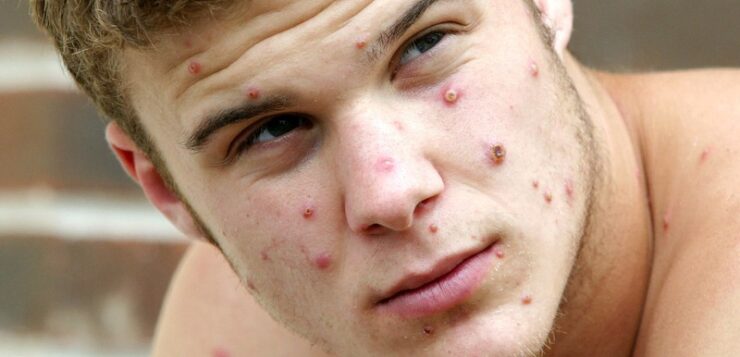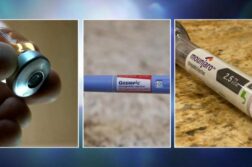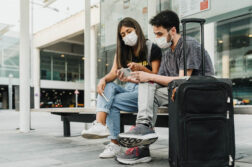By Jen Christensen and John Bonifield, CNN

(CNN) Anyone can get monkeypox, but in the latest outbreak, the virus is predominantly spreading among gay and bisexual men. Officials noted Monday that most of the people affected reported some level of sexual activity.
That doesn’t mean the virus is sexually transmitted, but officials say it shows that prolonged skin-to-skin contact is one of the major ways monkeypox is now spreading.
As of Monday evening, data from the US Centers for Disease Control and Prevention shows 1,972 probable or confirmed monkeypox cases in the US.
As of now, the risk of monkeypox is low, according to the CDC, but public health experts say there are still things you can do to protect yourself, especially if you’re in the pool of higher-risk people.
That pool includes men who have sex with men, particularly those who have had multiple sexual partners in the past two weeks in an area with known monkeypox cases.
Here’s what to know.
How monkeypox spreads
Symptoms usually start within three weeks of exposure to the monkeypox virus and last two to four weeks.
The virus typically triggers a rash with lesions that can be extremely painful. The pain may even be enough to push some people to go to the hospital, but that seems to be rare.
The rash often starts on the face and spreads to other parts of the body, the CDC says. Some people will also have a fever at first.
A person with monkeypox can give the virus to others at any point until their rash has healed, the scabs have fallen off and they have a fresh layer of skin on the affected area.
The virus transmits primarily though close, skin-on-skin physical contact, but it can also spread when you touch objects like sheets or towels that may have been used by somebody with monkeypox, as well as through close face-to-face interactions like kissing.
This outbreak is a little different
The latest outbreak looks a little different, according to Dr. Demetre Daskalakis, director of the CDC’s Division of HIV/AIDS Prevention.
Monkeypox isn’t considered a sexually transmitted disease, but most people who have gotten it in the US recently report some level of sexual activity, he said Monday. That can include penetrative encounters as well as oral sex.
«Some people have had the rash all over their body or different parts of their body, but there are many who are presenting with the genital and anal lesions as their first indication of illness,» Daskalakis said. «That sort of speaks for that close prolonged contact.»
The virus may theoretically be transmitted through respiratory droplets, he said, but the CDC is not seeing that happen in this outbreak.
«I can’t prove how efficient it is. It doesn’t seem to be very efficient. So it’s more contact with skin to skin, more than face-to-face contact.
«But in the harm reduction discussion, it’s really important to say what we know and don’t know,» Daskalakis said. «It’s just important for folks to know that it’s not impossible to transmit monkeypox that way so they can really adjust behavior as needed.»
Parties vs. bars
Scientists are still studying how monkeypox is spreading in this outbreak, but they say people don’t seem to be getting sick after, say, walking past someone or giving them a hug and brushing past a lesion on their skin.
«If it’s a hug that doesn’t necessarily include a shirt, there’s a theoretical risk of transmission there, but that’s not what we’re hearing in terms of what’s happening with our cases, so it’s lower risk. I can’t say zero risk,» Daskalakis said.
Rather, it’s longer contact that seems to be responsible for most cases now. «If you were to ask me how long ‘long’ is, I can’t answer that question, but it seems as if it’s possible that this is not being transmitted by a light brush,» Daskalaskis said.
A circuit party, a large dance party that can attract thousands of men and last through a night or weekend, could be one way the virus spreads. Dancing shirtless at a party that has good ventilation, without interacting with someone who has visible lesions, is probably low-risk. If there’s an after-party that leads to sex, that’s much riskier.
In enclosed spaces such as back rooms, saunas or sex clubs, or at sex parties where there’s often anonymous contact with multiple partners, there may be a higher likelihood of spreading monkeypox, the CDC says.
A typical gay bar where people go to hang out is different.
«Socializing is a part of what [LGBTQ people] do. So I don’t think that it’s something that we stop. It’s just sort of important to have awareness how monkeypox transmits and you’re aware of your own risk and how to mitigate that risk,» Daskalakis said.
How to protect yourself
Researchers are also investigating whether the virus can be spread by someone who has no symptoms, or through semen, vaginal fluids and fecal matter, according to the CDC.
The CDC says that wearing a condom may help, but alone, it probably will not protect against the spread of monkeypox. However, the agency still emphasizes that condoms can prevent other sexually transmitted infections.
There is a vaccine to protect against monkeypox, but demand for it far outstrips supply.
One thing people can do to protect themselves until the supply improves is to avoid contact with those who are clearly infected, especially close face-to-face contact like kissing.
«In line with our harm reduction guidance, thinking about reducing your number of partners, potentially trying to avoid anonymous contacts ends up being smart from the perspective of decreasing the risk of exposure,» Daskalakis said.
The CDC says people might want to reduce skin contact as much as possible by having sex with clothes on or after covering areas where the rash is present.
If you choose to have sex with someone who has monkeypox or who might have been exposed to it, talk about the virus ahead of time.
Officials also say to keep in mind that their advice could change as scientists learn more. It may change if monkeypox starts to spread through other contact, such as when people live closely together in places like homeless shelters or when people play full-contact sports.
«I think the most important thing is that it’s good to have awareness and some level of worry about some of these things, but it’s not paralysis,» Daskalakis said. «Realistically speaking, skin-on-skin contact of any variety theoretically can transmit monkeypox, but what we’re seeing is, you kind of have to work at it a bit.»





